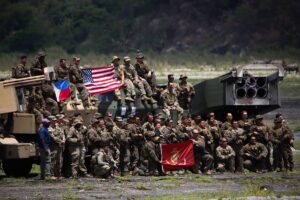AGAINST the backdrop of the 2024 Balikatan Exercise, also called “Salaknib 24,” the United States, for the first time since the end of the Cold War, has deployed the land-based Mid-Range Capability (MRC) missile system in the Asia-Pacific region, specifically in Northern Luzon.
It has the capacity to launch Tomahawk cruise missiles and SM-6 missiles, thus revealing the true answer as to why the US withdrew from the Intermediate-Range Nuclear Forces Treaty in 2019: to pave the way for the expansion of the deployment of medium- and long-range strategic forces in the Asia-Pacific. Such a move by the US, in cooperation with President Ferdinand Marcos Jr.’s administration, has significant implications for the strategic calculus and configuration of the region. It also has adverse critical ramifications for the relationship between the Philippines and China. Northern Luzon is geographically close to Taiwan, the South China Sea (SCS) and the Chinese mainland, which are Beijing’s strategic interests.
Deploying a missile system like the MRC system in Northern Luzon carries profound strategic significance. It prompts us to consider potential outcomes: could this be the beginning of “Cold War 2.0,” a pervasive and long-term struggle for global supremacy between the traditional superpower, the US, alongside its Western allies, and the rise of a contending great power — China — together with major powers like Russia, that will shape international relations for years to come? Are we witnessing echoes of history reminiscent of the Cuban Missile Crisis of 1962, which happened after the Soviet Union put nuclear missiles in Cuba, just 90 miles from the US coast — a direct and dangerous confrontation between those two superpowers during the Cold War that is often cited as the moment when the Cold War came closest to turning into a nuclear one, which was perceived by the US as a significant threat to its national security? What are the potential implications? These questions compel us to delve deeper into the evolving geopolitical landscape and its implications for global stability.
Cold War 2.0?
The concept of a Cold War 2.0 is not merely a historical analogy but a potential scenario that could reshape global dynamics. It depicts a return to a global climate characterized by sustained geopolitical tension and competition between major powers without direct military conflict, reminiscent of the original Cold War.
Some indications reminiscent of the Cold War include the intensified strategic rivalry between major powers today, especially between the US and China. The increased competition and military buildup in the Indo-Pacific region, including deploying advanced missile systems like the MRC, signifies a hardening of strategic rivalry.
Likewise, the US’ involvement in regional conflicts or support for different factions as a third-party state — for instance, supporting Israel in the Israel-Hamas war, with Iran being drawn into this conflict; the hybrid proxy war between Ukraine and Russia, where the US is supporting and supplying arms to Kyiv to fight Moscow; and US interference in the SCS dispute, to which it is not a party, using the Philippines as its proxy — in many ways mirror the proxy wars of the Cold War. There’s also an attempt by the US to decouple from China economically, echoing the divided economic systems of the Cold War era.
There’s also the US attempt to project an ideological divide and differences between the democratic and so-called authoritarian, mirroring the ideological contest of the Cold War as it orchestrates the formation and strengthening of its international alliances, such as the Quad (Quadrilateral Security Dialogue between the US, India, Japan and Australia), Aukus, (Australia, the United Kingdom and the US), the US-Japan-Republic of Korea trilateral framework, and the tripartite pact/alliance between the Philippines, Japan and the US, reflecting a US-led and -centric security architecture in the Asia-Pacific, with the ultimate objective to counterbalance China, which suggest a bifurcation similar to Cold War alliances.
In addition, the intensifying strategic rivalry among major powers today includes the battle for the support of global public opinion and narratives. Nevertheless, unlike the Cold War of the 20th century, Cold War 2.0 might involve battles in cyberspace and control over information, including disinformation campaigns.
Implications
Moreover, deploying the missile system in the Philippines for joint military exercises this month is not just a “black day” for the Asia-Pacific; it signifies a pivotal military move by the US within the geopolitical landscape of Asia, which cannot be overlooked. This marks the first time the system has been deployed overseas and underscores a focus on enhancing US land power capacity and capabilities for regional joint military operations.
The deployment aligns with the US’ objective of bolstering collective readiness and interoperability with the Philippines, which is considered America’s oldest military outpost and treaty ally in the region and the battleground of the US Indo-Pacific strategy. This step not only demonstrates the advancing military partnership between the US and the Philippines but also potentially serves as a precursor to the more permanent basing of such missile systems in the Western Pacific.
Like the Cuban Missile Crisis scenario, the US deploying the missile system in the Philippines, in close proximity to a major power or rival like China, could be seen as a significant change in military capabilities in a sensitive region. The missile system’s introduction in the region could alter the strategic balance, much as the Soviet missiles in Cuba were intended to. The MRC’s stated purpose could be compared to the use of the missiles in Cuba — whether they are meant for deterrence, defense or as a potential threat. Also, the presence of such a missile system could raise tensions internationally and between certain countries, as did the missiles in Cuba. However, the response from countries within and outside the region, and the potential for diplomatic resolutions or escalations would depend on what happens next.
On the other hand, the implications of this move may vary for China and other countries in the region. For China, this deployment could be considered a US containment strategy, a challenge to its military capabilities and standing in the region or its perceived sphere of influence. China may also view the deployment as provocative, potentially leading to an arms race or encouraging it to take more assertive measures in asserting its claims, especially in the SCS and toward Taiwan.
It might also potentially catalyze China to expedite further its own military modernization and deployments in the region, a series of events that could significantly alter the regional security architecture and dynamics. Such deployments could also exacerbate the already intensifying tensions between China and the Philippines.
For other countries in the region, it may be perceived as the beginning of a more volatile, unpredictable and tension-driven regional security landscape. Introducing such capabilities on Philippine soil could contribute to a regional arms race, with other countries feeling pressured to develop or acquire similar or counterbalancing capabilities, potentially increasing the likelihood of an arms race in the region.
Conclusion
It’s important to note that while the current deployment is for the Balikatan Exercise’s purposes, the US Army’s Pacific commander has indicated plans for the US Army to field newly developed long-range precision fire capabilities in the Indo-Pacific this year, with the Typhon system having hypersonic capabilities. This could signal an increasing emphasis on rapid deployment and flexibility in response to regional security scenarios.
The actual outcome of all these would depend not only on the actions and reactions of the various stakeholders involved and their strategic calculations, but also on their engagement in diplomatic efforts to manage rising tensions and maintain peace and stability in the region, a responsibility that should not be underestimated and of primordial importance.
Source: The Manila Times
https://www.manilatimes.net/2024/04/27/opinion/columns/are-we-in-cold-war-20-mode/1943444



